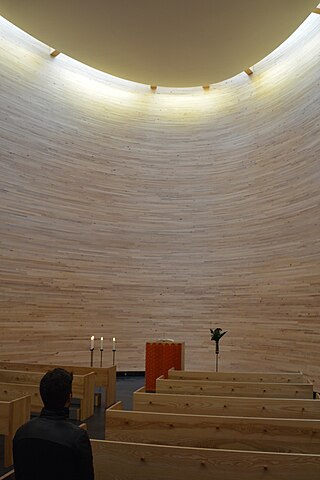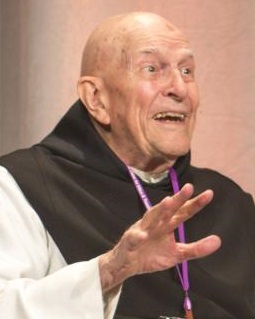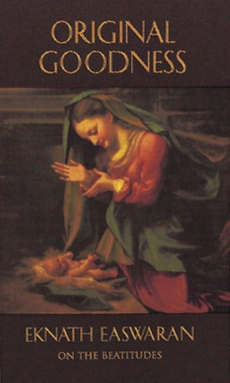Related Research Articles

Thomas Merton, religious name M. Louis, was an American Trappist monk, writer, theologian, mystic, poet, social activist and scholar of comparative religion. In December 1941 he entered the Trappist Abbey of Gethsemani and in May 1949 he was ordained to priesthood. He was a member of the convent of the Abbey of Our Lady of Gethsemani, near Bardstown, Kentucky, living there from 1941 to his death.

Christian mysticism is the tradition of mystical practices and mystical theology within Christianity which "concerns the preparation [of the person] for, the consciousness of, and the effect of [...] a direct and transformative presence of God" or divine love. Until the sixth century the practice of what is now called mysticism was referred to by the term contemplatio, c.q. theoria, from contemplatio, "looking at", "gazing at", "being aware of" God or the divine. Christianity took up the use of both the Greek (theoria) and Latin terminology to describe various forms of prayer and the process of coming to know God.

The Cloud of Unknowing is an anonymous work of Christian mysticism written in Middle English in the latter half of the 14th century. The text is a spiritual guide on contemplative prayer. The underlying message of this work suggests that the way to know God is to abandon consideration of God's particular activities and attributes, and be courageous enough to surrender one's mind and ego to the realm of "unknowing", at which point one may begin to glimpse the nature of God.
Timothy James "Matthew " Fox is an American priest and theologian. Formerly a member of the Dominican Order within the Catholic Church, he became a member of the Episcopal Church following his expulsion from the order in 1993.

Eckhart Tolle is a German-born spiritual teacher and self-help author. His books include The Power of Now: A Guide to Spiritual Enlightenment (1997), A New Earth: Awakening to Your Life's Purpose (2005) and the picture book Guardians of Being (2009).

In a religious context, the practice of contemplation seeks a direct awareness of the divine which transcends the intellect, often in accordance with religious practices such as meditation or prayer.

Christian meditation is a form of prayer in which a structured attempt is made to become aware of and reflect upon the revelations of God. The word meditation comes from the Latin word meditārī, which has a range of meanings including to reflect on, to study, and to practice. Christian meditation is the process of deliberately focusing on specific thoughts and reflecting on their meaning in the context of the love of God.

Richard Rohr, is an American Franciscan priest and writer on spirituality based in Albuquerque, New Mexico. He was ordained to the priesthood in the Roman Catholic Church in 1970, founded the New Jerusalem Community in Cincinnati in 1971, and the Center for Action and Contemplation in Albuquerque in 1987. In 2011, PBS called him "one of the most popular spirituality authors and speakers in the world".
Centering prayer is a form of Christian contemplative prayer, to center awareness on the presence of God. This modern movement in Christianity was initiated by three Trappist monks of St. Joseph's Abbey in Spencer, Massachusetts in the 1970s, Fr. William Meninger, Fr. M. Basil Pennington and Abbot Thomas Keating, in response to the growing popularity of Asian meditation methods.

Thomas Keating, O.C.S.O. was an American Catholic monk and priest of the Order of Cistercians of the Strict Observance. Keating was known as one of the principal developers of Centering Prayer, a contemporary method of contemplative prayer that emerged from St. Joseph's Abbey in Spencer, Massachusetts.
Quietism is the name given to a set of contemplative practices that rose in popularity in France, Italy, and Spain during the late 1670s and 1680s, particularly associated with the writings of the Spanish mystic Miguel de Molinos, and which were condemned as heresy by Pope Innocent XI in the papal bull Coelestis Pastor of 1687. "Quietism" was seen by critics as holding that man's highest perfection consists in a sort of psychical self-annihilation and a consequent absorption of the soul into the Divine Essence even during the present life.
Catholic spirituality includes the various ways in which Catholics live out their Baptismal promise through prayer and action. The primary prayer of all Catholics is the Eucharistic liturgy in which they celebrate and share their faith together, in accord with Jesus' instruction: "Do this in memory of me." The Catholic bishops at the Second Vatican Council decreed that "devotions should be so drawn up that they harmonize with the liturgical seasons, accord with the sacred liturgy, are in some fashion derived from it, and lead the people to it, since, in fact, the liturgy by its very nature far surpasses any of them." In accord with this, many additional forms of prayer have developed over the centuries as means of animating one's personal Christian life, at times in gatherings with others. Each of the religious orders and congregations of the Catholic church, as well as lay groupings, has specifics to its own spirituality – its way of approaching God in prayer to foster its way of living out the Gospel.
Joel Solomon Goldsmith was an American spiritual author, teacher, spiritual healer, and modern-day mystic. He founded The Infinite Way movement.
Mystical theology is the branch of theology in the Christian tradition that deals with divine encounter and the self-communication of God with the faithful; such as to explain mystical practices and states, as induced by contemplative practices such as contemplative prayer, called theoria from the Greek for contemplation.

Below is a bibliography of published works written by Thomas Merton, the Trappist monk of The Abbey of Our Lady of Gethsemani. Several of the works listed here have been published posthumously. The works are listed under each category by date of publication.

Monastic silence is a spiritual practice recommended in a variety of religious traditions for purposes including becoming closer to God and achieving elevated states of spiritual purity. It may be in accordance with a monk's formal vow of silence, but can also engage laity who have not taken vows, or novices who are preparing to take vows.

Original Goodness is a practical commentary on the Sermon on the Mount, emphasizing how to translate it into daily living with the aid of spiritual practices. Written by Eknath Easwaran, the book was originally published in the United States in 1989.
Below is a bibliography of published works written by Dutch-born Catholic priest Henri Nouwen. The works are listed under each category by year of publication. This includes 42 books, four of which were published posthumously, along with 51 articles and 4 chapters which are lists in process. Also listed below are 31 of the forewords, introductions, and afterwords which he wrote for others' works. Finally, the list of 32 readers and compilations continues to grow as material from his work is incorporated into new publications.
Jon M. Sweeney is an author of popular history, spirituality, biography, poetry, fiction for young readers, and memoir. His most frequent subjects are Catholic, particularly St. Francis of Assisi, about whom Sweeney has written The St. Francis Prayer Book, Francis of Assisi in His Own Words, When Saint Francis Saved the Church, The Complete Francis of Assisi, and The Enthusiast, a biography that Richard Rohr calls "An immense and important contribution to our understanding of the great saint."
References
- 1 2 Crider, Glenn (2006). "Interview with James Finley" (PDF). The Thomas Merton Center at Bellairmine University. The Merton Annual. Retrieved 17 August 2023.
- ↑ Kohls, Ryan (13 April 2023). "An Interview with James Finley". ProgressiveChristianity.org. Retrieved 17 August 2023.